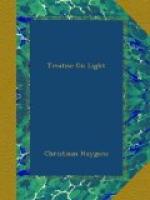[Illustration]
There is the further consideration in the emanation of these waves, that each particle of matter in which a wave spreads, ought not to communicate its motion only to the next particle which is in the straight line drawn from the luminous point, but that it also imparts some of it necessarily to all the others which touch it and which oppose themselves to its movement. So it arises that around each particle there is made a wave of which that particle is the centre. Thus if DCF is a wave emanating from the luminous point A, which is its centre, the particle B, one of those comprised within the sphere DCF, will have made its particular or partial wave KCL, which will touch the wave DCF at C at the same moment that the principal wave emanating from the point A has arrived at DCF; and it is clear that it will be only the region C of the wave KCL which will touch the wave DCF, to wit, that which is in the straight line drawn through ab. Similarly the other particles of the sphere DCF, such as bb, dd, etc., will each make its own wave. But each of these waves can be infinitely feeble only as compared with the wave DCF, to the composition of which all the others contribute by the part of their surface which is most distant from the centre A.
One sees, in addition, that the wave DCF is determined by the distance attained in a certain space of time by the movement which started from the point A; there being no movement beyond this wave, though there will be in the space which it encloses, namely in parts of the particular waves, those parts which do not touch the sphere DCF. And all this ought not to seem fraught with too much minuteness or subtlety, since we shall see in the sequel that all the properties of Light, and everything pertaining to its reflexion and its refraction, can be explained in principle by this means. This is a matter which has been quite unknown to those who hitherto have begun to consider the waves of light, amongst whom are Mr. Hooke in his Micrographia, and Father Pardies, who, in a treatise of which he let me see a portion, and which he was unable to complete as he died shortly afterward, had undertaken to prove by these waves the effects of reflexion and refraction. But the chief foundation, which consists in the remark I have just made, was lacking in his demonstrations; and for the rest he had opinions very different from mine, as may be will appear some day if his writing has been preserved.




